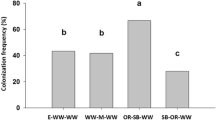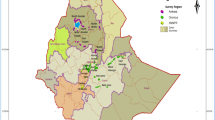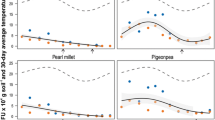Abstract
The incidence of stem base and root diseases of cereals in New Zealand was measured over a 3-year period to determine their relationships with soil and crop management factors. Samples were collected from 142 New Zealand wheat and barley crops during the milky ripe stage of crop growth and the proportion of tillers affected by stem base and root diseases in each crop was assessed. Take-all (caused by Gaeumannomyces graminis), and sharp eyespot (caused by Rhizoctonia cerealis) were common, whereas crown rot (caused by Fusarium spp.) was present at only low levels and eyespot (caused by Tapesia spp.) was not recorded. Incidence of both take-all and sharp eyespot was greater in wheat crops (mean of 8.3 and 12.6% tillers infected, respectively) than in barley (1.7 and 4.4%). Previous crop was the main factor associated with take-all in wheat crops. Incidence was highest where wheat followed wheat (mean of 29.3% tillers infected), and higher after barley, grass or clover than after other break crops. Although take-all incidence was high in most successive wheat crops, incidence was low (<20%) in a substantial proportion. A 1-year break from wheat was almost as effective as a longer break in reducing take-all levels in a subsequent wheat crop. Sowing month was the factor most closely associated with sharp eyespot incidence in wheat. Crops sown in early autumn had the highest incidence, whereas crops sown in winter and spring had only low levels of sharp eyespot. Several Fusarium species were associated with crown rot in wheat and barley. Fusarium avenaceum, F. crookwellense and F. culmorum were present in all regions, but F. pseudograminearum, F. semitectum and Microdochium nivale were more limited in distribution.
Similar content being viewed by others
References
Backhouse D, Burgess LW (2002) Climatic analysis of the distribution of Fusarium graminearum, F. pseudograminearum and F. culmorum on cereals in Australia. Australasian Plant Pathology 31, 321–327. doi: 10.1071/AP02026
Bateman GL (1993) Development of disease symptoms and fungal pathogens on shoot bases in continuous winter wheat and effects of fungicides. Plant Pathology 42, 595–608.
Blair ID, Morrison L (1949) Wheat diseases and insect pests. Information Series No. 3. (Department of Scientific and Industrial Research: Wellington)
Braithwaite M, Alexander BJR, AdamsRLM(1998) Nationwide survey of pests and diseases of cereal and grass seed crops in New Zealand. 2. Fungi and bacteria. In ‘Proceedings of the 51st NewZealand Plant Protection Conference’. pp. 51–59.
Burgess LW, Backhouse D, Summerell BA, Pattison AB, Klein TA, et al. (1993) Long-term effects of stubble management on the incidence of infection of wheat by Fusarium graminearum. Australian Journal of Experimental Agriculture 33, 451–456. doi: 10.1071/ EA9930451
Burgess LW, Summerell BA, Bullock S, Gott KP, Backhouse D (1994) ‘Laboratory manual for Fusarium research’. 3rd edn. (University of Sydney: Sydney)
Colbach N, Maurin N, Huet P (1996) Influence of cropping system on foot rot of winter wheat in France. Crop Protection 15, 295–305. doi: 10.1016/0261-2194(95)00150-6
Colbach H, Lucas P, Cavelier N, Carvelier A (1997) Influence of cropping system on sharp eyespot in winter wheat. Crop Protection 16, 415–422. doi: 10.1016/S0261-2194(97)00018-5
Cook RJ (1981a) The effect of soil reaction and physical conditions. In ‘Biology and control of take-all’. (Eds MJC Asher, PJ Shipton) pp. 343–352. (Academic Press: London)
Cook RJ (1981b) The influence of rotation crops on take-all decline phenomenon. Phytopathology 71, 189–192.
Cook RJ (2003) Take-all of wheat. Physiological and Molecular Plant Pathology 62, 73–86. doi: 10.1016/S0885-5765(03)00042-0
Cromey MG, Butler R, Boddington HJ, Moorhead AR (2002) Effects of sharp eyespot on yield of wheat in New Zealand. New Zealand Journal of Crop and Horticultural Science 30, 9–17.
Cromey MG, Butler RC, Munro CA, Shorter S (2005) Susceptibility of New Zealand wheat cultivars to sharp eyespot. New Zealand Plant Protection 58, 268–272.
Hardwick NV, Jones DR, Slough JE (2001) Factors affecting diseases of winter wheat in England and Wales, 1989–98. Plant Pathology 50, 453–462. doi: 10.1046/j.1365-3059.2001.00596.x
Huber DM (1981) The role of nutrients and chemicals. In ‘Biology and control of take-all’. (Eds MJC Asher, PJ Shipton) pp. 317–341. (Academic Press: London)
Kear BS, Gibbs HS, Miller RB (1967) Soils of the Downs and Plains Canterbury and North Otago New Zealand. Soil Bureau Bulletin 14. NZ Department of Scientific and Industrial Research.
King AC, Cole ALJ, Sanderson FR (1986) Prochloraz insensitivity in isolates of the cereal eyespot fungus Pseudocercosporella herpotrichoides in New Zealand. Australasian Plant Pathology 15, 22–23. doi: 10.1071/APP9860022
Kirkegaard JA, Sarwar M, Wong PTW, Mead A, Howe G, Newell M (2000) Field studies on the biofumigation of take-all by Brassica break crops. Australian Journal of Agricultural Research 51, 445–456. doi: 10.1071/AR99106
Kollmorgen JF, Griffiths JB, Walsgott DN (1983) The effects of various crops on the survival and carry-over of the wheat take-all fungus Gaeumannomyces graminis var. tritici. Plant Pathology 32, 73–77.
Mathre DE (1997) ‘Compendium of barley diseases.’ 2nd edn. (APS Press: St. Paul)
NZ Soil Bureau (1968) General survey of the Soils of the South Island, New Zealand. Soil Bureau Bulletin 27. NZ Department of Scientific and Industrial Research.
Ophel-Keller K, McKay A (2001) Root disease testing service: delivery and commercialization. In ‘Proceedings of the Second Australian Soilborne Diseases Symposium’. pp. 17–18.
Parry DW (1990) The incidence of Fusarium spp. in stem bases of selected crops of winter wheat in the Midlands, UK. Plant Pathology 39, 619–622.
Pitt D (1964) Studies on sharp eyespot disease of cereals. I. Disease symptoms and pathogenicity of isolates of Rhizoctonia solani Kühn and the influence of soil factors and temperature on disease development. Annals of Applied Biology 54, 77–89.
Polley RW, Thomas MR (1991) Surveys of diseases of winter wheat in England and Wales, 1976–1988. Annals of Applied Biology 119, 1–20.
Richardson MJ, Cook RJ (1985) Rhizoctonia on small-grain cereals in Great Britain. In ‘Ecology and Management of Soilborne Plant Pathogens’. (Eds CA Parker, AD Rovira, KJ Moore, PTW Wong, JF Kollmorgen) pp. 63–65. (American Phytopathological Society: St. Paul)
Sanderson FR, King AC (1988) Field occurrence of Tapesia yallundae, the teleomorph of Psueudocercosporella herpotrichoides. Australasian Plant Pathology 17, 20–21. doi: 10.1071/APP9880020
Scott PR (1981) Variation in host susceptibility. In ‘Biology and control of take-all’. (Eds MJC Asher, PJ Shipton) pp. 219–236. (Academic Press: London)
Swan LJ, Backhouse D, Burgess LW (2000) Surface soil moisture and stubble management practice effects on the progress of infection of wheat by Fusarium pseudograminearum. Australian Journal of Experimental Agriculture 40, 693–698. doi: 10.1071/EA99106
Wiese MV (1987) ‘Compendium of wheat diseases.’ 2nd edn. (APS Press: St. Paul)
Windels CE, Wiersma JV (1992) Incidence of Bipolaris and Fusarium on subcrown internodes of spring barley and wheat grown in continuous conservation tillage. Phytopathology 82, 699–705.
Author information
Authors and Affiliations
Corresponding author
Rights and permissions
About this article
Cite this article
Cromey, M.G., Parkes, R.A. & Fraser, P.M. Factors associated with stem base and root diseases of New Zealand wheat and barley crops. Australasian Plant Pathology 35, 391–400 (2006). https://doi.org/10.1071/AP06032
Received:
Accepted:
Issue Date:
DOI: https://doi.org/10.1071/AP06032




